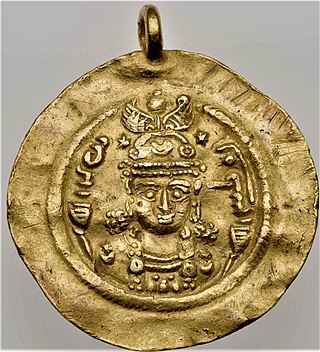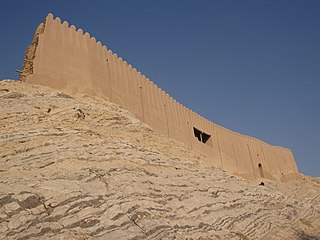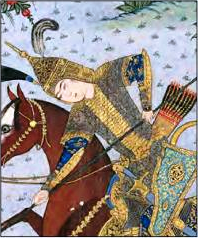
Khosrow II, also known as Khosrow Parviz, is considered to be the last great Sasanian king (shah) of Iran, ruling from 590 to 628, with an interruption of one year.

Yazdegerd III was the last Sasanian King of Kings of Iran from 632 to 651. His father was Shahriyar and his grandfather was Khosrow II.

Shahrbaraz, was shah (king) of the Sasanian Empire from 27 April 630 to 9 June 630. He usurped the throne from Ardashir III, and was killed by Iranian nobles after forty days. Before usurping the Sasanian throne he was a spahbed (general) under Khosrow II (590–628). He is furthermore noted for his important role during the climactic Byzantine–Sasanian War of 602–628, and the events that followed afterwards.

Boran was Sasanian queen of Iran from 630 to 632, with an interruption of some months. She was the daughter of king Khosrow II and the Byzantine princess Maria. She is the second of only three women to rule in Iranian history, the others being Musa of Parthia, and Boran's sister Azarmidokht.

Rostam Farrokhzād was an Iranian dynast from the Ispahbudhan family, who served as the spahbed of the northwestern quarter (kust) of Adurbadagan during the reign of Boran and Yazdegerd III. Rostam is remembered as a historical figure, a character in the Persian epic poem Shahnameh, and as a touchstone of most Iranian nationalists.
The Seven Great Houses of Iran, also known as the seven Parthian clans, were seven feudal aristocracies of Parthian origin, who were allied with the Sasanian court. The Parthian clans all claimed ancestry from Achaemenid Persians.

Bahrām Chōbīn or Wahrām Chōbēn, also known by his epithet Mehrbandak, was a nobleman, general, and political leader of the late Sasanian Empire and briefly its ruler as Bahram VI.

Azarmidokht was Sasanian queen regnant (banbishn) of Iran from 630 to 631. She was the daughter of king (shah) Khosrow II. She was the second Sasanian queen; her sister Boran ruled before and after her. Azarmidokht came to power in Iran after her cousin Shapur-i Shahrvaraz was deposed by the Parsig faction, led by Piruz Khosrow, who helped Azarmidokht ascend the throne. Her rule was marked by an attempt of a nobleman and commander Farrukh Hormizd to marry her and come to power. After the queen's refusal, he declared himself an anti-king. Azarmidokht had him killed as a result of a successful plot. She was, however, killed herself shortly afterwards by Rostam Farrokhzad in retaliation for his father's death. She was succeeded by Boran.

Hormuzan was a Persian aristocrat who served as the governor of Khuzestan, and was one of the Sasanian military officers at the Battle of al-Qādisiyyah. He was later taken prisoner by the Muslims after the fall of Shushtar in 642. Two years later, he was accused of the assassination of the Rashidun caliph Umar, and was killed by 'Ubaid-Allah, the deceased caliph's son.
Farrukhzad, was an Iranian aristocrat from the House of Ispahbudhan and the founder of the Bavand dynasty, ruling from 651 to 665. Originally a powerful servant of the Sasanian king Khosrow II, he, along with several other powerful aristocrats made a conspiracy against the latter and ended his tyrannical rule. They thereafter put Khosrow's son Kavadh II on the throne, whose rule lasted only a few months, before he was killed by a plague, being succeeded by his son Ardashir III, who was only after one year murdered by the rebellious former Sasanian army chief (spahbed) Shahrbaraz, who usurped the throne.

Vistahm or Bistam, was a Parthian dynast of the Ispahbudhan house, and maternal uncle of the Sasanian king of kings of Iran, Khosrow II. Vistahm helped Khosrow regain his throne after the rebellion of another Parthian noble Bahram Chobin, of House of Mihran, but later led a revolt himself, and ruled independently over a region which encompassed the entire Iranian East until he was defeated by Khosrow and his allies.

The Sasanian civil war of 589–591 was a conflict that broke out in 589, due to the great deal of dissatisfaction among the nobles towards the rule of Hormizd IV. The civil war lasted until 591, ending with the overthrow of the Mihranid usurper Bahram Chobin and the restoration of the Sasanian family as the rulers of Iran.

Farrukh Hormizd or Farrokh Hormizd, also known as Hormizd V, was an Iranian prince, who was one of the leading figures in Sasanian Iran in the early 7th-century. He served as the military commander (spahbed) of northern Iran. He later came in conflict with the Iranian nobility, "dividing the resources of the country". He was later killed by Siyavakhsh in a palace plot on the orders of Azarmidokht after he proposed to her in an attempt to usurp the Sasanian throne. He had two children, Rostam Farrokhzad and Farrukhzad.
The House of Ispahbudhan or the House of Aspahbadh was one of the seven Parthian clans of the Sasanian Empire. Like the Sasanians, they claimed descent from the Achaemenid dynasty. They also claimed descent from the legendary Kayanid figure Isfandiyar, who was the son of Vishtaspa, who according to Zoroastrian sources was one of Zoroaster's early followers.
Piruz Khosrow, also known as Piruzan or Firuzan, was a powerful Persian aristocrat who was the leader of the Parsig (Persian) faction that controlled much of the affairs of the Sasanian Empire during the Sasanian civil war of 628-632. He was killed at the Battle of Nahāvand in 642.
The Sasanian civil war of 628–632, also known as the Sasanian Interregnum was a conflict that broke out after the execution of the Sasanian king Khosrau II between the nobles of different factions, notably the Parthian (Pahlav) faction, the Persian (Parsig) faction, the Nimruzi faction, and the faction of general Shahrbaraz. Rapid turnover of rulers and increasing provincial landholder power further diminished the empire. Over a period of four years and 14 successive kings, the Sasanian Empire weakened considerably, and the power of the central authority passed into the hands of its generals, contributing to its fall.
Mihran Bahram-i Chubin was an Iranian nobleman from the House of Mihran. He was the son of Bahram Chobin, the famous Sasanian spahbed and briefly shahanshah. Mihran, with the aid of Christian Arab tribes, fought against the Muslim Arabs at Ayn al-Tamir. He was however, defeated. What happened to Mihran afterwards is unknown; however, it is known that he had a son named Siyavakhsh, who fell to the Arabs in 651 at Ray.

The Battle of Ray was fought between the Sasanians and the Rashidun Caliphate in 651. It was also part of the rivalry between the Ispahbudhan family and the Mihran family.

Gordiya was an influential Iranian noblewoman from the House of Mihran, who was first the sister-wife of the distinguished military leader Bahram Chobin, then the wife of the Ispahbudhan dynast Vistahm, and ultimately the wife of the last prominent Sasanian emperor, Khosrow II.













